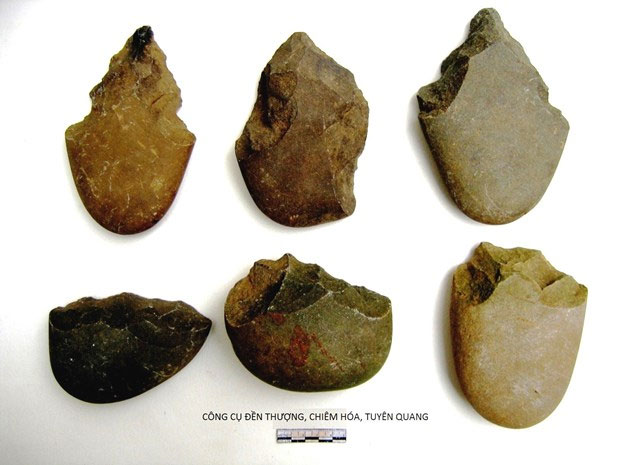Discovering many cultural relics of primitive people in Tuyen Quang
Scientists have discovered that the relics are in common are the hill-shaped hillocks quite close to each other, which is an ancient river floor distributed on the right bank of Gam river.
At the beginning of April 2019, Vietnam Archaeological Institute in coordination with Tuyen Quang Provincial Museum discovered many places with cultural vestiges of primitive people in the mountains and hills of Dong Quac and Tan Lap villages ( in Binh Nhan commune, Chiem Hoa district) and Thuong temple relic in Vinh Quang commune (Chiem Hoa district).

Working tools of the post-Stone Age residents live about 20,000 years ago.(Source: vass.gov.vn).
On May 8, talking to PV, Associate Professor-PhD Trinh Nang Chung (Vietnam Institute of Archeology), Head of Survey and Archeological Survey, said: "During the survey of archaeological investigations studying in Chiem Hoa district, we discovered traces of primitive people , the relics of common characteristics are the high- shaped bowl of hills close to each other, which is an ancient river floor distributed on the right bank. Gam river These hills are being cultivated for cassava, corn and vegetables, we have discovered hundreds of stone relics on the surface of the monument or buried dozens of centimeters deep under the ground ".
In the hills of Dong Quac and Tan Lap hamlets, the survey team discovered dozens of pebble tools with typical Son Vi culture, working tools of the post-Stone Age residents. now about 20,000 years.
Relics include pointed tools, rough smashing tools, rough axes, stone scrapers, stone knives. The survey team also found the tools of stone and stone pieces, proving that the working tools were manipulated by the original people.
In the hill area Thuong temple along Gam river in an area of more than 5,000m 2 of the survey team discovered hundreds of stone artifacts characterized by many prehistoric periods. The earliest date is the rudimentary labor tools with the versatility of primitive people similar to those found in Dong Quac and Tan Lap villages.
All the tools are crafted from pebbles of rivers and streams, with crude rudimentary techniques that feature the old Stone Age tool, about 20,000 years ago.
The survey team also found labor tools with more advanced processing techniques with different types of tools that have been clearly defined functions such as short axes, oval axes, tools close to the disk shape. These are tools created by the Neolithic era residents, in the Hoa Binh culture, dating back to 8,000-9,000 years ago.
Also in the area, the surveyed Senate Temple also found many Dong Son copper arrows, copper arrows and Dong Son bronze-bronze workers, dating back more than 2,000 years ago.
According to Associate Professor-PhD Trinh Nang Chung, the above documents show that the location of Thuong Temple is a relatively continuous residence of many generations of residents, from the Stone Age to the Neolithic era. Entering the age of the Metal Age, this area could be a rather large residence of Dong Son residents during the Hung Vuong period. This is a rare type of monument in the northern mountainous region of Vietnam.
In addition to the above relics, at Loong Cha cave (Dong Ngu village, Binh Nhan commune), archaeologists have discovered some axes grinding quadrilateral and coarse pottery on the surface of the cave. Initially, the survey team stated that this is the residence of the post-Neolithic residents, about 4,000 years ago.
Experts are continuing to study the above locations and plan to excavate Loong Cha cave in the future.
- Discovering more relics of the temple in Tran Dynasty in the XIII-XIV century in Tuyen Quang
- Tuyen Quang: Discovering many ancient monuments in Son Duong
- Detecting primitive human relics
- Discover an ancient religious relic in Tuyen Quang
- Discovering vestiges of caverns in Tuyen Quang
- Discovered a prehistoric tomb in Tuyen Quang
- Discovering an ancient village of 3500 years old at Bai Soi, Tuyen Quang
- Found primitive human relics
- 'Beijing gibbon' in Zhoukou Du - China
- Tuyen Quang: Discovered the ancient wreck in the Lo River
- Archaeological findings 2012 - Ancient coins in Tuyen Quang
- Discover a unique way of shroud in Tuyen Quang
 Discovered an ancient centipede fossil 99 million years old
Discovered an ancient centipede fossil 99 million years old Discovered bat-like dinosaurs in China
Discovered bat-like dinosaurs in China Discovered a 200-year-old bronze cannon of the coast
Discovered a 200-year-old bronze cannon of the coast Discover 305 million-year-old spider fossils
Discover 305 million-year-old spider fossils